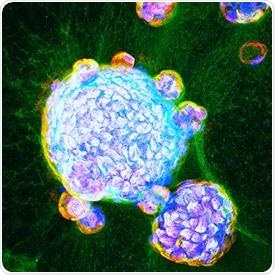The emergence of the COVID-19 pandemic in the United States in early 2020 left researchers struggling to identify lab models of SARS-CoV-2 infection, the respiratory virus that causes COVID-19. Animal models failed, and efforts to grow adult human lungs were unsuccessful as most cell types did not survive.

Lung organoids are human stem cell-derived “mini lungs” in a laboratory dish. Image Credit: University of California San Diego.
Undiscouraged by these challenges, stem cell scientists, cardiothoracic surgeons, infectious disease experts, and cell biologists from the University of California San Diego School of Medicine worked together to see if they can cross multiple hurdles.
The researchers reported the first adult human “lung-in-a-dish” models, also called lung organoids that portray all cell types in the study published on August 31st, 2021, in the journal eLife. They also report that SARS-CoV-2 infection of the lung organoids imitates actual patient lung infections and discloses the specialized roles different cell types perform in infected lungs.
This human disease model will now allow us to test drug efficacy and toxicity, and reject ineffective compounds early in the process, at ‘Phase 0,’ before human clinical trials begin.”
Pradipta Ghosh, Professor and Director, Institute for Network Medicine
Pradipta Ghosh, MD, is also the executive director of the HUMANOID Center of Research Excellence (CoRE) at UC San Diego School of Medicine.
Ghosh co-led the research with Soumita Das, PhD, associate professor of pathology at UC San Diego School of Medicine and founding co-director and chief scientific officer of HUMANOID CoRE.
Stem cell researchers at the HUMANOID CoRE, headed by Das, reproducibly created three lung organoid lines from adult stem cells derived from human lungs, which were removed surgically owing to lung cancer. Using a special cocktail of growth factors, the researchers were able to sustain cells that constitute both the upper and lower airways of human lungs, as well as specialized alveolar cells called AT2.
Upon infecting the lung organoids with SARS-CoV-2, the researchers found that the upper airway cells are crucial for the virus to institute infection, while the lower airway cells are vital for the immune response. Both the cell types contribute to the excitable immune response, at times termed a cytokine storm that is seen in severe cases of COVID-19.
A computational group headed by Debashis Sahoo, PhD, assistant professor of pediatrics at UC San Diego School of Medicine and of computer science and engineering at Jacobs School of Engineering, substantiated the new lung organoids by matching their gene expression patterns—which genes are “off” or “on.”
They compared the patterns indicated in the lungs of patients who succumbed to the disease to those that they earlier unearthed from databases of viral pandemic patient data.
The lung organoids, whether infected or not with SARS-CoV-2, functioned similar to actual lungs. In a one-to-one comparison employing the same criterion (gene expression patterns), the scientists revealed that their adult lung organoids imitated COVID-19 more than any other present laboratory model.
Other models—for instance, fetal lung-derived organoids and models that depend only on upper airway cells—permitted powerful viral infection but were unsuccessful in eliciting an immune response.
Our lung organoids are now ready to use to explore the uncharted territory of COVID-19, including post-COVID complications, such as lung fibrosis. We have already begun to test drugs for their ability to control viral infection—from entry to replication to spread—the runaway immune response that is so often fatal, and lung fibrosis.”
Soumita Das, Associate Professor, Pathology, University of California San Diego School of Medicine
As their observations in human organoids are much similar to human disease compared to results from animal models or cell lines, the researchers anticipate that successful drug candidates can be promptly advanced to clinical trials.
Because our HUMANOID CoRE lung organoids are scalable, personalized, propagatable, and cost-effective, they are quite unlike any other existing model.”
Pradipta Ghosh, Professor and Director, Institute for Network Medicine
“This is a significant advance that can enable the modeling of lung diseases and pandemics beyond COVID-19. In fact, other academic and industry partners are already beginning to use these organoids in disease modeling and drug discovery. This is when I feel that translational research is immediately transformative,” added Ghosh.
Source:
Journal reference:
Tindle, C., et al. (2021) Adult stem cell-derived complete lung organoid models emulate lung disease in COVID-19. eLife. doi.org/10.7554/eLife.66417.